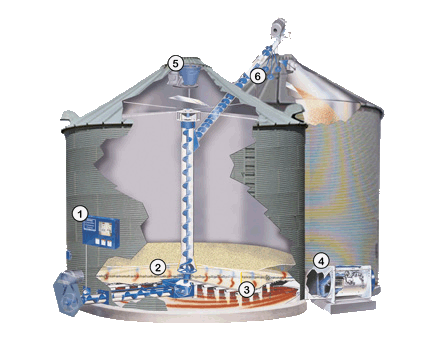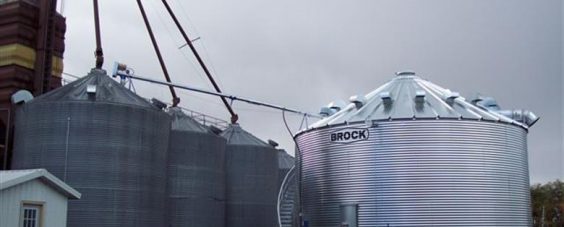Shivvers Performance Systems are a customizable package of components engineered to work together to provide optimum performance for drying grain, using continuous Counter-Flow technology. Shivvers can customize a drying system for your operation to dry up to 245,000 bushels per week.
How does a Shivvers Performance System work?
With a Shivvers Performance System, grain is spread evenly in the drying bin with your choice of grain spreader (5). Air is heated and blown into the plenum, the area under the perforated drying floor (3) by Shivvers heater and fan combinations (4). The heated air flows up through the grain, drying the layer of grain on the floor while warming the grain above, thus using every BTU of heat energy produced.

The tapered sweep augers (2) remove an even layer of grain and bring it to the center vertical auger where it is lifted up to the moisture sensor to determine moisture content. If the grain has reached the desired setting, the CompuDry® Command Center (1) turns on the continuous flow auger (6) to transfer the grain to storage.
If any grain hasn’t yet reached the desired moisture, the CompuDry® Command Center turns off the augers and allows the grain to dry for a calculated period of time before re-testing, spreading the wet grain back to the top of the drying grain bed. It will never transfer grain until it is dried to your selected setting.
Custom Designed Specifically for your Operation
Whether yours is a small farm with a few hundred acres or a larger operation with several thousand acres, there is a Shivvers Performance System that is right for you.
Expandable
As you operation grows, you may find a need for more capacity with your drying. Instead of pulling out your dryer to replace it with a new one, Shivvers has your answer. With you choice of Vane Axial Fans, Turbo Boosters or Centrifugal Fans & Heaters, you can expand your system for greater capacity at any time.
Efficiency
Since the heated air is in contact with the grain for a longer period of time (due to the depth of grain versus a thin column) all the heat is used from the heated air to remove moisture before it is exhausted. This makes for higher efficiency.
Higher Test Weight
Because the grain is in contact with the heated air for a longer period of time at a lower temperature, this results in a higher test weight with the removal of the same amount of moisture.


